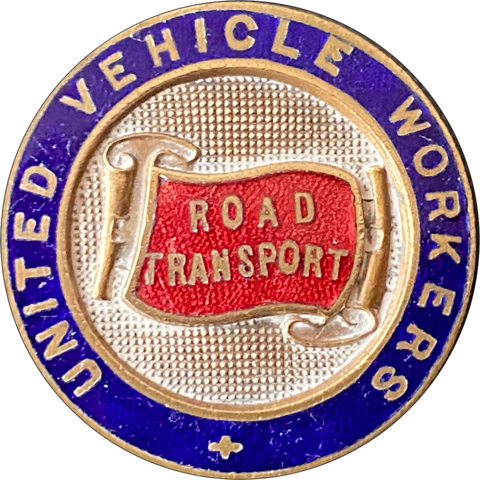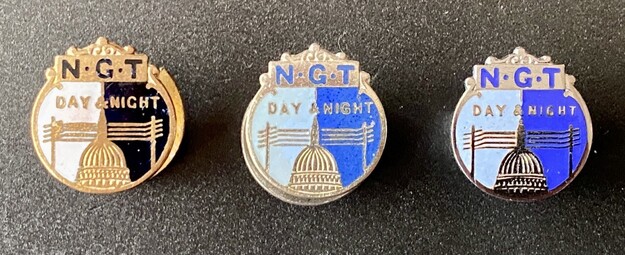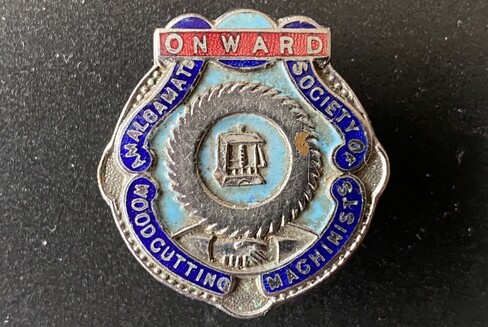Mark Crail · @markcrail
284 followers · 115 posts · Server mastodonapp.ukVery happy to have added this to my collection of trade union badges. The National Federation of Women Workers operated as a trade union from 1906-1921, before merging into the National Union of General and Municipal Workers. If you want to know more, I recommend the work of historian Cathy Hunt, who has published books on both the NFWW and its leading light, Mary Macarthur https://cathyhunthistorian.com/
#LabourHistory #TradeUnionHistory #TradeUnionBadges
#LabourHistory #TradeUnionHistory #TradeUnionBadges
Mark Crail · @markcrail
273 followers · 107 posts · Server mastodonapp.ukAn indignant-looking pot on this Ceramic and Allied Trades Union badge. The CATU emerged from a series of mergers in 1970, but traced its roots back to the early years of the twentieth century. It eventually merged into the GMB. #TradeUnionBadges #TradeUnionHistory
#TradeUnionBadges #TradeUnionHistory
Mark Crail · @markcrail
273 followers · 107 posts · Server mastodonapp.ukAn indignant-looking pot on this Ceramic and Allied Trades Union badge. The CATU emerged from a series of mergers in 1970, but traced its roots back to the early years of the twentieth century. It eventually merged into the GMB. #TradeUnionBadges #TradeUnionHistory
#TradeUnionBadges #TradeUnionHistory
Mark Crail · @markcrail
265 followers · 104 posts · Server mastodonapp.ukHere’s a selection of agricultural workers’ union badges to mark #PloughMonday - traditionally the first day back at work after Christmas. Hope you’ll all be dragging a plough round the village today, collecting donations and ploughing up the doorsteps of those who won’t donate #TradeUnionBadges #histodons
#ploughmonday #TradeUnionBadges #histodons
Mark Crail · @markcrail
265 followers · 104 posts · Server mastodonapp.ukHere’s a selection of agricultural workers’ union badges to mark #PloughMonday - traditionally the first day back at work after Christmas. Hope you’ll all be dragging a plough round the village today, collecting donations and ploughing up the doorsteps of those who won’t donate #TradeUnionBadges #histodons
#ploughmonday #TradeUnionBadges #histodons
Mark Crail · @markcrail
265 followers · 104 posts · Server mastodonapp.ukI believe this badge is from the United Vehicle Workers trade union that enjoyed only a brief existence before becoming part of the TGWU in 1922, though I can find no record of it incorporating “road transport’ in its name.
#LabourHistory #TradeUnionHistory #TradeUnionBadges
#LabourHistory #TradeUnionHistory #TradeUnionBadges
Mark Crail · @markcrail
252 followers · 86 posts · Server mastodonapp.uk#LabourHistory #TradeUnionBadges #Histodons
The National Union of Clerks was founded in 1890; what would become the Association of Women Clerks and Secretaries in 1903. They merged in 1941 to form the Clerical and Administrative Workers Union. After further name changes and mergers it is now the white collar section of the GMB.
#LabourHistory #TradeUnionBadges #histodons
Mark Crail · @markcrail
252 followers · 86 posts · Server mastodonapp.uk#LabourHistory #TradeUnionBadges #TradeUnionHistory
Adopting this name in 1928, the National Union of Printing, Bookbinding and Paperworkers emerged from the mergers of numerous small and specialist unions, some of which traced their roots back to the 1820s. It went on to absorb further unions over the years, and in 1966 merged with NATSOPA to form the Society of Graphical and Allied Trades. Its archives are kept in the Modern Records Centre at Warwick University https://mrc.epexio.com/records/NPB
#LabourHistory #TradeUnionBadges #TradeUnionHistory
Mark Crail · @markcrail
252 followers · 86 posts · Server mastodonapp.ukThree UK trade union badges produced by the National Guild of Telephonists. Founded in 1928 following a split in the Union of Postal Workers, the left-led union appointed guild socialist Edgar Lansbury as general secretary. It survived until 1978, unwisely rejecting merger terms with the UPW before effectively being taken over by the electricians’ union, the EETPU, in 1978.
@histodons #LabourHistory #TradeUnionBadges
#LabourHistory #TradeUnionBadges
Mark Crail · @markcrail
252 followers · 86 posts · Server mastodonapp.ukAnother trade union badge…
When the National Union of Tailors and Garment Workers merged into the GMB in 1991, it took its eye-catching scissors logo with it. The tailors’ union could trace its origins back to the 1850s, and by 1950 had around 130,000 members. But the industry’s decline saw membership halve over the next forty years. @histodons #LabourHistory #TradeUnionHistory #TradeUnionBadges
#LabourHistory #TradeUnionHistory #TradeUnionBadges
Mark Crail · @markcrail
203 followers · 45 posts · Server mastodonapp.ukThe National Union of Railwaymen always produced pretty good badges, but this one might be a bit unexpected. In fact, from the 1920s onwards, the NUR recruited significant numbers of bus workers, as this article explains https://sslh.org.uk/2022/01/17/on-the-buses-how-the-national-union-of-railwaymen-organised-bus-workers/
@histodons #LabourHistory #TradeUnionBadges #TransportHistory
#LabourHistory #TradeUnionBadges #TransportHistory
Mark Crail · @markcrail
173 followers · 34 posts · Server mastodonapp.ukToday’s trade union badge is brought to you by the National Union of Boot and Shoe Operatives, which operated from 1873 till 1971.
After the UK footwear industry went into decline, and jobs disappeared, the union merged with other leather-working unions to form the National Union of Footwear, Leather and Allied Trades. With further mergers it became part of Community.
#RedShoes #LabourHistory #TradeUnionBadges
#RedShoes #LabourHistory #TradeUnionBadges
Mark Crail · @markcrail
173 followers · 34 posts · Server mastodonapp.ukEye-catching National Union of Railwaymen badge. Nice colours. The NUR was founded in 1913, but traced its origins to 1872 and the birth of the Amalgamated Society of Railway Servants. In 1990 it merged with the seamen’s union to form the RMT. Despite its name, the union somewhat reluctantly recruited women during the First World War, and also organised bus workers, ferry crews and hotel staff. Good short account of the union’s history at https://warwick.ac.uk/services/library/mrc/archives_online/exhibitions/nur/
#LabourHistory #TradeUnionBadges
#LabourHistory #TradeUnionBadges
Mark Crail · @markcrail
172 followers · 30 posts · Server mastodonapp.ukA bit of humour in this #TradeUnion badge: the bird is an auk - and the union’s initials spell A W C S. The Association of Women Clerks and Secretaries was founded in 1903, and though it did recruit men, women made up most of its members and leadership. It merged in 1941 to become part of the Clerical and Allied Workers Union, later Apex and now the GMB. @histodons #LabourHistory #TradeUnionBadges
#TradeUnion #LabourHistory #TradeUnionBadges
Mark Crail · @markcrail
172 followers · 30 posts · Server mastodonapp.ukLook at the amazing colours on this #TradeUnion badge!
The Glasgow-based Scottish Commercial Motormen’s Union was founded in 1898 as the Scottish Carters Association. The union’s early leaders made a serious error in focusing recruitment efforts on carters, believing that motor vehicles were passing fad, and lost members in the 1920s to the new Transport and General Workers Union. The SCMU eventually merged with the TGWU in 1971. #LabourHistory #TradeUnionBadges
#TradeUnion #LabourHistory #TradeUnionBadges
Mark Crail · @markcrail
135 followers · 7 posts · Server mastodonapp.ukFounded in Birmingham in 1866, and after various name changes becoming the Amalgamated Society of Woodcutting Machinists in 1919, the ASWM survived until 1971 when it merged with the National Union of Furniture Trade Operatives to form the Furniture, Timber and Allied Trades Union.
#LabourHistory #TradeUnions #TradeUnionBadges
#LabourHistory #tradeunions #TradeUnionBadges













